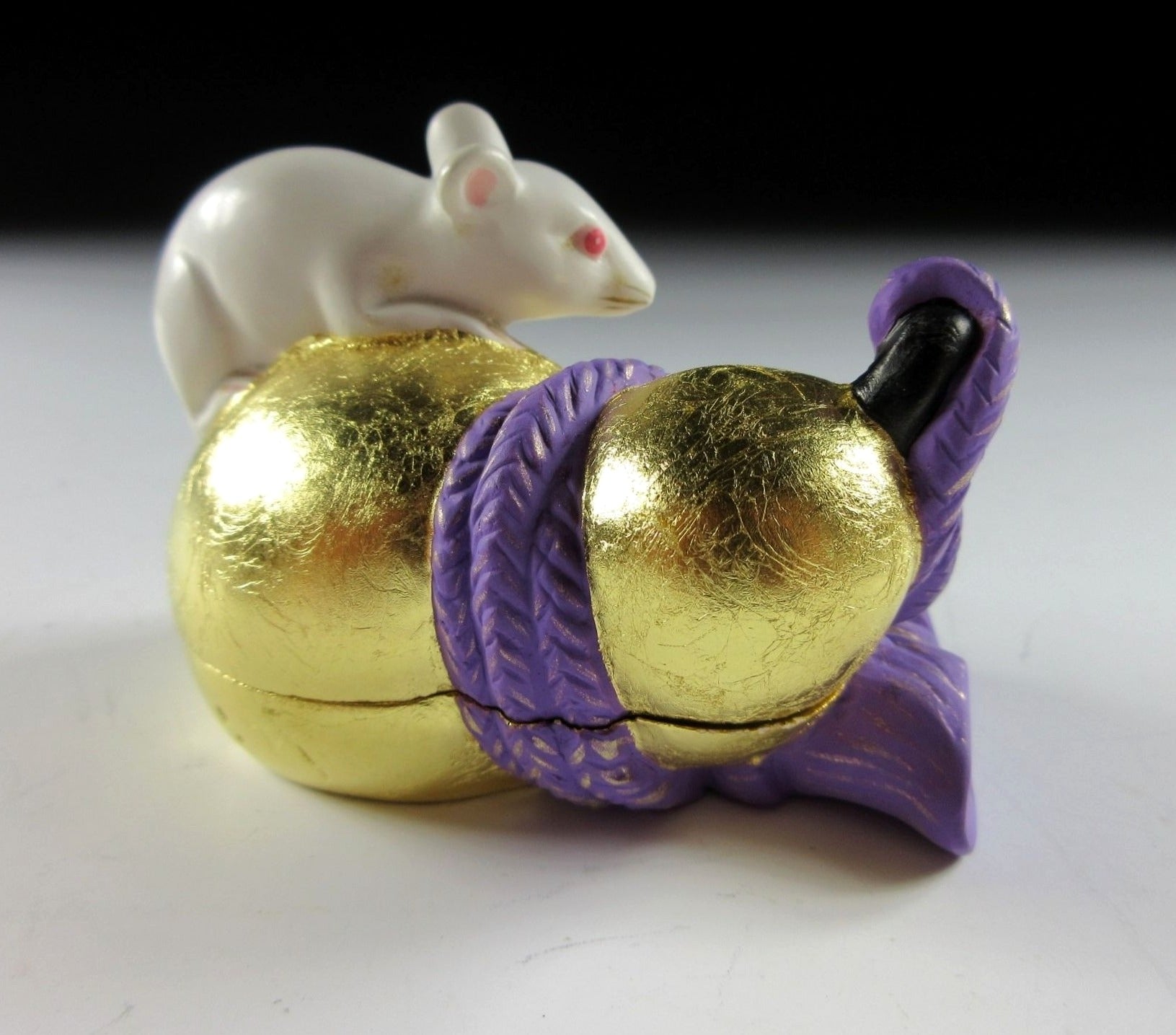Kominka Zakka
Nishito Tetsusaburo II Hakata Year of the Rat Kogo
Nishito Tetsusaburo II Hakata Year of the Rat Kogo
Couldn't load pickup availability
*SHIPPING OPTIONS VARY DEPENDING ON THE DESTINATION, PLEASE SCROLL TO THE END OF THIS LISTING FOR MORE DETAILS.
This listing is for a superb Hakata kogo made around 20 years ago by Hakata ningyo master, Nishito Tetsusaburo II. It is quite large and moulded to resemble a white rat perched on a gold gourd. The glaze work consists of matte gesso, the same material used for dolls, and the gourd is decorated with layers of gold leaf. This piece is suitable for holding both woodchip and kneaded incense, although pottery kogo are typically used for kneaded incense during the cooler months. It was most likely made to commemorate the Year of the Rat back in 1996, and it comes with its original signed wooden storage box. It also comes with two (one red crepe and one plain yellow) wrapping cloths for when the item is not in use, as well as a very detailed Japanese language profile paper about the first and second generation masters. There’s also a smaller paper about the twelve animals of the Chinese zodiac.
Nishito Tetsusaburo II (b. Tetsuya 1948) was born in Fukuoka City as a Hakata doll maker and the first son of Intangible Cultural Property Tetsusaburo Nishito I (1921-1996). He began studying under his father in 1970 and two years later his work was selected for the Fukuoka City Art Exhibition. In 1973 he received the Board of Education Award at the Fukuoka City Art Exhibition, and in 1979 he received the Excellence Award at the New Product Development Exhibition. In 1980 he presented a doll named ‘Haru’ to the Takamatsunomiya Imperial Household, and in 1983 he received the Minister of International Trade and Industry Award at the New Hakata Doll Exhibition. In 1989 he received the Excellence Award at the Asian-Pacific Exposition Commemorative Exhibition, and 700 dolls were exhibited at the Expo. In 1991 he was certified as a Traditional Craftsperson by the Ministry of Education Trade and Industry, and in 1996 he presented a kogo incense holder to the Akishinomiya Imperial family. He also received two awards at the National Traditional Craft Festival Hina Doll Contest, and he held his first solo exhibition at Sogo Department store in Ogura. He held another at the Daimaru Osaka Umeda Art Gallery. In 1998 he held a solo exhibition at the Kumamoto Traditional Crafts Museum, and another at Fukuoka NHK Gallery. In 2000 he received the Gold Medal Award at the New Product Development Exhibition, and he held a solo exhibition at Hotel Shusui-en in Ibusuki City, Kagoshima Prefecture. He succeeded his father as the second generation master of the family business ‘Goto Hakata Ningyo’, and he held a commemorative exhibition at Hakata Daimaru Department Store. He also received an award from the Mayor of Fukuoka for Outstanding Achievement. In 2001 he held a solo exhibition at Kitsuki City in Oita Prefecture, and another in Hamamatsu city in Shizuoka Prefecture. He held two other exhibitions in Nihonbashi in Tokyo and Yokohama Keikyu Department Store. In 2002 he held private exhibitions in Oita and Saga, and in Oita and Kumamoto in 2003. He also received the Fukuoka Prefecture Traditional Crafts Promotion Achievement Award. In 2004 he exhibited in Tokyo, and in 2007 he received the Interior Award/Idea Award at the 1st Hakata Doll Interior Exhibition. Three years later he received the Asahi Shimbun Award at the Fukuoka Traditional Crafts Exhibition, and he held a solo exhibition at Daimaru Department store in Osaka. In 2011 he donated a Prince Kaneyoshi ningyo to Kikuchi City Hall in Kumamoto Prefecture, and he received the Fukuoka City Technical Achievement Award. In 2013 he received the Fukuoka Prefecture Governor's Award for Technical Excellence. In 2014 he became a member of the Fukuoka City Art Federation and the Fukuoka Prefecture Cultural Group Federation. **Fellow sellers, this information was researched by Kominka Zakka and CANNOT be used in your own listings.
Kogo are for holding incense during the tea ceremony. Kogo vary depending on the season. In summer wooden kogo are used for holding chips of incense wood, and in winter ceramic kogo are used for holding kneaded incense intended for the hearth. During the tea ceremony, incense is added to the charcoal fire during the charcoal-laying procedure.
Sizes
Box: H.9.9cm (3.8”) x 12.4cm (4.8”) x 8.8cm (3.4”)
Kogo: H.5.1cm (2”) x L.7.8cm (3”) x W.4.6cm (1.8”)
Condition
It’s in very good condition aside from a few spots on the rat. The gold part looks like there are bumps and holes, these are gold foil over the signature of the craftsman.
THESE ARE SHIPPING ESTIMATES BASED ON THE CURRENT GLOBAL SITUATION
**Germany, France, Greece, Spain, Poland, Austria, Slovakia, Lithuania, Slovenia: NO SHIPPING. Very strict and expensive packaging laws in place and we are not licensed to send products to these countries. We have no plan to register at this time because the process is in some cases very expensive and complicated, plus each country has its own set of regulations and application process.
**USA, UK, Canada, Australia, New Zealand, Switzerland, Norway: Airmail Small Packet (approx. 15-28 days). Combined shipping available up to 2kgs for Airmail Small Packet (please send us a message).
**Asia: Airmail Small Packet (approx. 15-21 days). Combined shipping available up to 2kgs for Airmail Small Packet (please send us a message).
**Central Asia, Middle East, South Africa, Brazil, Mexico: EMS Express 10-15 days.
**Russia: No shipping methods available.
Share




















